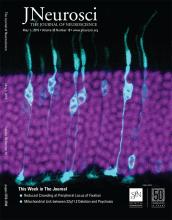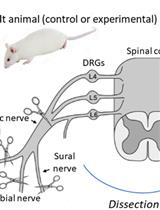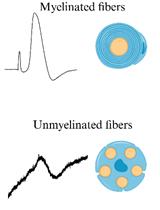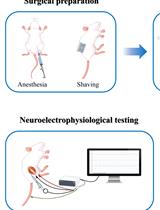- EN - English
- CN - 中文
Sciatic Nerve Cut and Repair Using Fibrin Glue in Adult Mice
纤维蛋白胶在成年小鼠坐骨神经损伤修复中的应用
(*contributed equally to this work) 发布: 2019年09月20日第9卷第18期 DOI: 10.21769/BioProtoc.3363 浏览次数: 5246
评审: Oneil G. BhalalaAlexandros C KokotosLinlin Sun
Abstract
Peripheral nerve injury (PNI) is an excellent model for studying neural responses to injury and elucidating the mechanisms that can facilitate axon regeneration. As such, several animal models have been employed to study regenerative mechanisms after PNI, including Aplysia, zebrafish, rabbits, cats and rodents. This protocol describes how to perform a sciatic nerve injury and repair in mice, one of the most frequently used models to study mechanisms that facilitate recovery after PNI, and that takes advantage of the availability of many genetic models. In this protocol, we describe a method for using fibrin glue to secure the proximal and distal stumps of an injured nerve in close alignment. This method facilitates the alignment of nerve stumps, which aids in regeneration of both sensory and motor axons and allows successful reconnection with peripheral targets.
Keywords: Nerve (神经)Background
Peripheral nerve injuries (PNIs) are an important clinical problem and recovery outcomes are generally poor (Jensen et al., 2001; Höke and Brushart, 2010). Additionally, treatments for these injuries have not much changed in the last 100 years (Mundie, 1920; Taylor et al., 2008). As such, models of PNI have become important to understand potential barriers to regeneration and treatments for enhancing it. While in humans and larger mammals, such as cats, suturing through the epineurium is a common mechanism of repair (Lundborg, 2002; Grinsell and Keating, 2014; Raslan et al., 2014), this treatment is not reliably performed in mice. First, the diameter of the sciatic nerve is less than 2 mm making the placement of epineurial sutures technically challenging. Second, in comparison to nerves in larger animals, axons in mouse nerves are more likely to exude from cut nerves or “mushroom out” when the epineurium is penetrated during placement of sutures, making clean repair of the cut nerves difficult. Finally, placement of sutures in small rodents can interfere with the blood supply of regenerating nerves. One method that can overcome these challenges is the use of fibrin glue, a tool that was first utilized in human patients (Egloff and Narkas, 1983; MacGillivray, 2003). The implementation of fibrin glue in experimental animals (as models to assess its benefits for human nerve repair) also has a long history; decades ago it was found to be as effective as epineurial sutures for repair of the rat sciatic nerve (Nishihira, 1988). We describe a method to repair a mouse sciatic nerve injury that facilitates nerve regeneration in experimental situations. First, we use a fibrin glue formula, derived from human and bovine blood components, that was previously found to enhance repair in central nervous system axon tracts (Guest et al., 1997). Second, we secure the nerve by adhering it to a silastic mat prior to transection. This ensures a minimal gap between the proximal and distal nerve stumps and enhanced stability, without having to leave a piece of the epineurium intact, which is a technically difficult approach and can result in leaving some axons uninjured. The improved coaptation and increased stability diminishes the incidence of dehiscence reported without suture stabilization (Cruz et al., 1986). While the components of fibrin glue may interact with the immune system (Schoenecker et al., 2001; Mosesson, 2005; Kelsh et al., 2014), this strategy has been used extensively in both rats and mice with great success. Comprehensive comparisons of nerve repair efficiency using fibrin glues compared to epineurial sutures have been recently published (Adel et al., 2017; Koulaxouzidis et al., 2017, Wang et al., 2018). In our hands, the protocol described facilitates sciatic nerve reformation in mice by two months following injury as quantified by complete motor muscle reinnervation assessed by re-occupancy of neuromuscular junctions and electromyography with an almost 100% success rate (Wilhelm et al., 2012; Rotterman et al., 2019). As a further advantage, drugs or other compounds can be added to the glue to test how different factors administered peripherally (and directly on the nerve) may impact regeneration (Wilhelm et al., 2012). These nerve repair surgeries are all done in adult (3+ month) C57Blk/6 mice, but can easily be transferred to other species and ages.
Materials and Reagents
- Cohen-Vannas Scissors (Fine Science Tools, catalog number: 15000-01)
- Sterile Poly-lined drape (Medline, catalog number: NON21001)
- #3 and #5 Forceps
- Nose cone
- (Optional) Gelfoam® (Pfizer, catalog number: 1575-9039605)
- 10 μl pipette (Gilson, Pipetman, catalog number: F144802)
- SILASTIC® film (Dow Corning, catalog number: 501-1). This material is medical grade silicone rubber sheets specifically designed for implantation
- Surgical tape (Dynarex, Surgical Tape Cloth, catalog number: 3562)
- Sterile Stainless Steel Surgical Blades (Integra Militex Kai, catalog number: 4-311)
- 10 μl pipette tips (Lab Depot, MicroPette Universal Tips, catalog number: 750001)
- Sterile gauze (Fisherbrand, catalog number: 22-362-178)
- ½ ml Monoject Insulin Syringe, 29 G x ½” (Covidien, catalog number: 8881600350)
- Adult C57Blk/6 mice (3 months+ old, alternative animal strains can be used as well)
- *Thrombin (25 Units/ml in 45 mmol/L CaCl2) (MP BioChemicals, LLC, catalog number: 154163)
- *Fibrinogen (100 mg/ml) (Sigma, catalog number: F3879)
- *Fibronectin (8 mg/ml) (Sigma, catalog number: F1141)
- Buprenorphine hydrochloride (Rechitt Benckiser Healthcare (UK) Ltd., Buprenex® Injection, catalog number: RXBUPRENOR5 via shopmedvet.com)
- Lubricant Eye Ointment (Major Pharmaceuticals, LubriFeshTM P.M., catalog number: NDC 0904-6488-38)
- 5-0 Polydioxanone (KeeBomed, 20 mm reverse cutting Polydioxanone suture)
- Isoflurane, USP (Piramal Critical Care, material number: 400648037)
- 70% Isopropyl Alcohol (Medline, Medium Alcohol Prep Pads, catalog number: MDS090735
- Iodine (Medline, Medium Prep Pads Povidone-Iodine, USP, catalog number: NDC 53329-944-30)
- Hair Remover Lotion (Nair, Church and Dwight Co, catalog number: 70501345)
*Note: Aliquots of these components may be made up to 6 months in advance and stored separately at -20 °C until just prior to use. They must be mixed immediately prior to use as they begin to coagulate immediately.
Equipment
- Retractors (Fine Science Tools, Mini-Goldstein, catalog number: 17002-02)
- Electric hair clippers (Wahl, catalog number: 99160)
- Dissecting microscope (Olympus Tokyo, catalog number: 222855)
- Warm water pump (Gaymar, catalog number: TP-500)
- 2 Heating pads (one for surgery and one for recovery) (Adroit Medical Systems, catalog number: V016)
- Oxygen concentrator (SupraVet, Pureline oxygen concentrator, catalog number: OC6000)
- Isoflurane vaporizer (VetEquip, Vaporizer- Funnel-Fill, catalog number: 911103)
- Induction chamber, hoses, filters and connectors (VetEquip, Dual Procedure Circuit, catalog number: 921400)
- Cotton Tipped Applicators (MediChoice, catalog number: WOD1002)
- Dumont #3c (Fine Science Tools, catalog number: 11231-20)
- Secure Scalpel Handle #3 (Fine Science Tools)
Procedure
文章信息
版权信息
© 2019 The Authors; exclusive licensee Bio-protocol LLC.
如何引用
Readers should cite both the Bio-protocol article and the original research article where this protocol was used:
- Akhter, E. T., Rotterman, T. M., English, A. W. and Alvarez, F. J. (2019). Sciatic Nerve Cut and Repair Using Fibrin Glue in Adult Mice. Bio-protocol 9(18): e3363. DOI: 10.21769/BioProtoc.3363.
- Rotterman, T. M., Akhter, E. T., Lane, A. R., MacPherson, K. P., Garcia, V. V., Tansey, M. G. and Alvarez, F. J. (2019). Spinal motor circuit synaptic plasticity after peripheral nerve injury depends on microglia activation and a CCR2 mechanism. J Neurosci 39(18): 3412-3433.
分类
神经科学 > 周围神经系统 > 坐骨神经
神经科学 > 感觉和运动系统 > 脊髓
您对这篇实验方法有问题吗?
在此处发布您的问题,我们将邀请本文作者来回答。同时,我们会将您的问题发布到Bio-protocol Exchange,以便寻求社区成员的帮助。
提问指南
+ 问题描述
写下详细的问题描述,包括所有有助于他人回答您问题的信息(例如实验过程、条件和相关图像等)。
Share
Bluesky
X
Copy link














